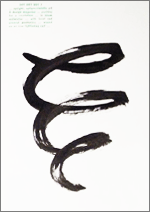 What’s not to like about a magazine that confronts graphic design issues with a smart, insightful, and polemic bent? No, I’m not talking about Emigre, I’m talking about Dot Dot Dot—another magazine in booklet format that’s small in size, but long on content.
What’s not to like about a magazine that confronts graphic design issues with a smart, insightful, and polemic bent? No, I’m not talking about Emigre, I’m talking about Dot Dot Dot—another magazine in booklet format that’s small in size, but long on content.
As evidenced in Emigre’s Rant, more designers are looking to share their voice these days, and they’re doing it through writing. Labeled an “after-hours, graphic design magazine intended to fill a gap in current arts publishing” by Dot Dot Dot’s editors, the magazine succeeds because of the talent it employs. Absent are universal themes or common problems. Instead, the writers deliver work with a personal investment—genuine and rich. Issue 7 of Dot Dot Dot provoked questions like these:
When is the poster a commodity?
Does a typeface affect the content, or does the content affect the typeface?
What ever came of Forum magazine?
If an artwork is an intellectual act, than how can it exist?
How can personal ideology mesh with work?
If money was pure, crisp, and devoid of graffiti, would you look at it the same way?
Rob Giampetro’s investigated The Problem with Posters. Giampetro framed his argument around Susan Sontag’s Introduction to The Art of the Revolution: 96 Posters from Cuba. Sontag stated, “A public notice aims to inform or command. A poster aims to exhort, to sell, to educate, to convince, to appeal.” Surely, posters can become commodities like the icons they satirize, mutilate, or glamorize.
On a more entertaining note, Experimental Jetset delivered a short list of truisms, ideals, methods, and observations. The sum of Lazy Sunday Afterthoughts, A collection of random notes left me wondering about all the lists I’ve made, full of rants and raves on life (design related or not). You can read the E.J. article here.
And as excellent as the profile on Brian Eno was, it struck me as out of place (here’s a musician/artist/producer appearing in a design journal.) But the farther I got into it, the more I was reminded that Eno is high on concept. His creativity knows no bounds. Currently, Eno’s Long Now Foundation aims to remind people that the earth is fragile, and that our actions today will effect the future—as far as 10,000 years later. This focus on the very distant future, places emphasis on our world and its future inhabitants. It’s a compassionate move on Eno’s part. When was the last time you were compassionate in your design work?
In Dot Dot Dot, you won’t discover how to find the perfect client, handle multiple layers in PhotoShop, or craft the best creative brief. Nor will you find advertisements—that often determine editorial content—interrupting your page flow. Dot Dot Dot (much like Emigre) projects the voices of a new generation, who are looking to share their thoughts about meaningful and worthwhile issues.
![]()
Published and edited by Stuart Bailey, Peter Bilak
Distributed by Actar, Princeton Architectural Press
ISBN: 907762001X
Dot Dot Dot






nice to see dotdotdot getting props here.
sounds well worth a read.
no too weird about eno; he's a visiting prof. at the royal college of art in london (for communication/design) and at the hochschule der kunst berlin (time based media, apart from him just being essential if you're interested in or make . . . anything (see oblique strategies).
good book worth checking-'the clock of the long now'-all about the project in dotdotdot. beautiful and inspiring. just like mr. eno.
On Mar.31.2004 at 09:39 PM